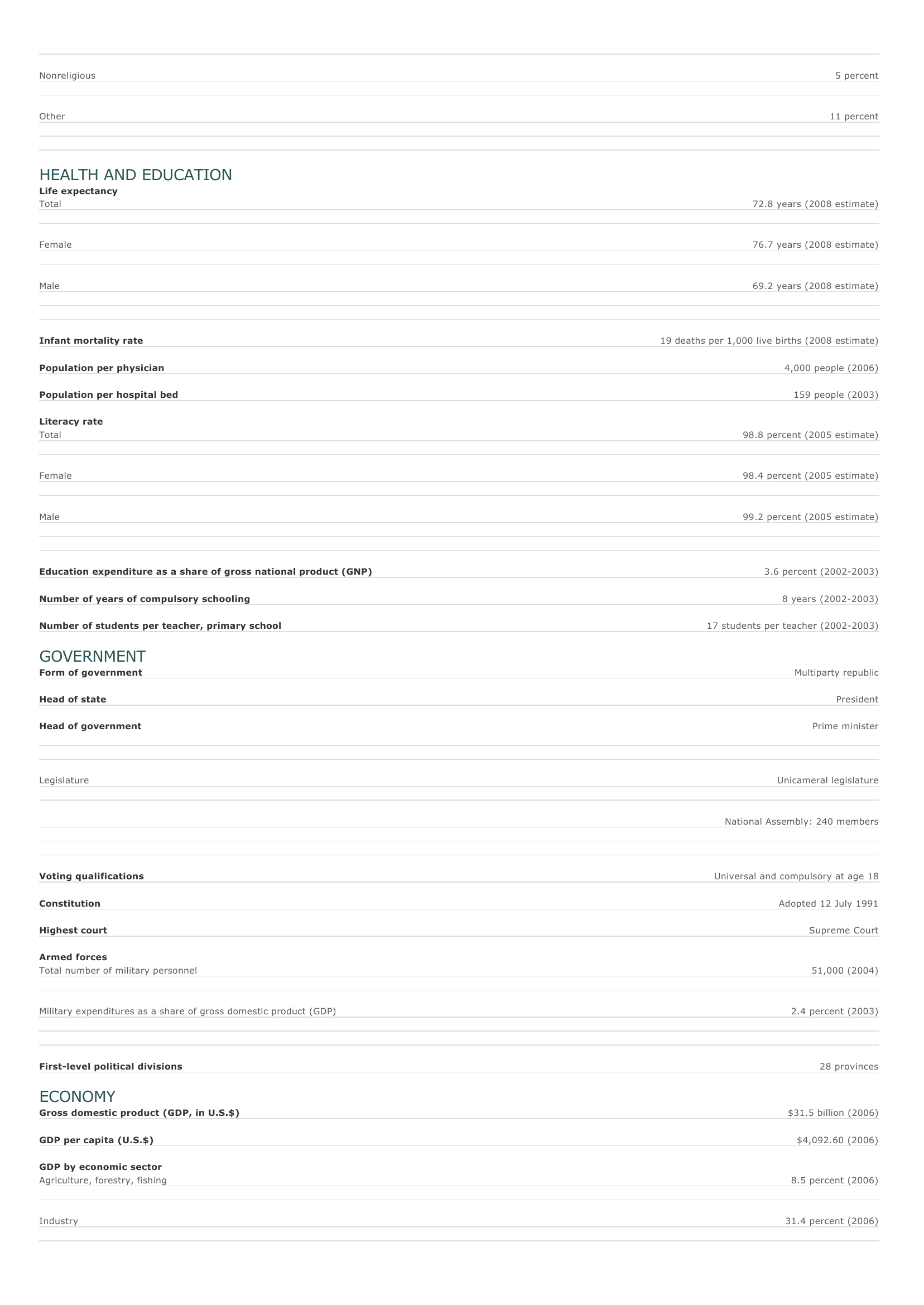Bulgaria Facts and Figures. BASIC FACTS Official name Capital Area Republic of Bulgaria Sofia 110,994 sq km 42,855 sq mi PEOPLE Population 7,262,675 (2008 estimate) Population growth Population growth rate -0.81 percent (2008 estimate) Projected population in 2025 6,257,716 (2025 estimate) Projected population in 2050 4,651,477 (2050 estimate) Population density 66 persons per sq km (2008 estimate) 170 persons per sq mi (2008 estimate) Urban/rural distribution Share urban 71 percent (2005 estimate) Share rural 29 percent (2005 estimate) Largest cities, with population Sofia 1,076,000 (2003 estimate) Plovdiv 340,638 (2001) Varna 314,539 (2001) Burgas 193,316 (2001) Ruse 162,128 (2001) Ethnic groups Bulgarian 85.3 percent Turkish 8.5 percent Roma (Gypsy) 2.6 percent Macedonian 2.5 percent A rmenian 0.3 percent Russian 0.2 percent O ther 0.6 percent Languages Bulgarian (official); secondary languages closely correspond to ethnic breakdown. Religious affiliations Bulgarian Orthodox 72 percent Muslim 12 percent Nonreligious O ther 5 percent 11 percent HEALTH AND EDUCATION Life expectancy Total 72.8 years (2008 estimate) Female 76.7 years (2008 estimate) Male 69.2 years (2008 estimate) Infant mortality rate Population per physician Population per hospital bed 19 deaths per 1,000 live births (2008 estimate) 4,000 people (2006) 159 people (2003) Literacy rate Total 98.8 percent (2005 estimate) Female 98.4 percent (2005 estimate) Male 99.2 percent (2005 estimate) Education expenditure as a share of gross national product (GNP) Number of years of compulsory schooling Number of students per teacher, primary school 3.6 percent (2002-2003) 8 years (2002-2003) 17 students per teacher (2002-2003) GOVERNMENT Form of government Head of state Head of government Legislature Multiparty republic President Prime minister Unicameral legislature National Assembly: 240 members Voting qualifications Constitution Universal and compulsory at age 18 Adopted 12 July 1991 Highest court Supreme Court Armed forces Total number of military personnel 51,000 (2004) Military expenditures as a share of gross domestic product (GDP) First-level political divisions 2.4 percent (2003) 28 provinces ECONOMY Gross domestic product (GDP, in U.S.$) GDP per capita (U.S.$) GDP by economic sector Agriculture, forestry, fishing I ndustry $31.5 billion (2006) $4,092.60 (2006) 8.5 percent (2006) 31.4 percent (2006) Services 60 percent (2006) Employment Number of workers 3,051,682 (2006) Workforce share of economic sector Agriculture, forestry, fishing 9 percent (2005) I ndustry 34 percent (2005) Services 57 percent (2005) Unemployment rate 12.1 percent (2004) National budget (U.S.$) Total revenue $11,598 million (2006) Total expenditure $10,028 million (2006) Monetary unit 1 new lev (Lv), consisting of 100 stotinki Major trade partners for exports Italy, Germany, Turkey, Greece, France Major trade partners for imports Russia, Germany, Italy, Greece, France ENERGY, COMMUNICATIONS, AND TRANSPORTATION Electricity production Electricity from thermal sources Electricity from hydroelectric sources Electricity from nuclear sources Electricity from geothermal, solar, and wind sources 52.06 percent (2003 estimate) 5.78 percent (2003 estimate) 42.14 percent (2003 estimate) 0.03 percent (2003 estimate) Number of radios per 1,000 people 537 (1997) Number of telephones per 1,000 people 321 (2005) Number of televisions per 1,000 people 453 (2000 estimate) Number of Internet hosts per 10,000 people 67 (2003) Daily newspaper circulation per 1,000 people 116 (1999) Number of motor vehicles per 1,000 people 360 (2004) Paved road as a share of total roads 99 percent (2004) SOURCES Basic Facts and People sections Area data are from the statistical bureaus of individual countries. Population, population growth rate, and population projections are from the United States Census Bureau, International Programs Center, International Data Base (IDB) (www.census.gov). Urban and rural population data are from the Food and Agriculture Organization (FAO) of the United Nations (UN), FAOSTAT database (www.fao.org). Largest cities population data and political divisions data are from the statistical bureaus of individual countries. Ethnic divisions and religion data are largely from the latest Central Intelligence Agency (CIA) World Factbook and from various country censuses and reports. Language data are largely from the Ethnologue, Languages of the World, Summer Institute of Linguistics International (www.sil.org). Health and Education section Life expectancy and infant mortality data are from the United States Census Bureau, International Programs Center, International database (IDB) (www.census.gov). Population per physician and population per hospital bed data are from the World Health Organization (WHO) (www.who.int). Education data are from the United Nations Educational, Scientific and Cultural Organization (UNESCO) database (www.unesco.org). Government section Government, independence, legislature, constitution, highest court, and voting qualifications data are largely from various government Web sites, the latest Europa World Yearbook, and the latest Central Intelligence Agency (CIA) World Factbook. The armed forces data is from Military Balance. Economy section Gross domestic product (GDP), GDP per capita, GDP by economic sectors, employment, and national budget data are from the World Bank database (www.worldbank.org). Monetary unit, agriculture, mining, manufacturing, exports, imports, and major trade partner information is from the statistical bureaus of individual countries, latest Europa World Yearbook, and various United Nations and International Monetary Fund (IMF) publications. Energy, Communication, and Transportation section Electricity information is from the Energy Information Administration (EIA) database (www.eia.doe.gov). Radio, telephone, television, and newspaper information is from the United Nations Educational, Scientific and Cultural Organization (UNESCO) database (www.unesco.org). Internet hosts, motor vehicles, and road data are from the World Bank database (www.worldbank.org). Note Figures may not total 100 percent due to rounding. Microsoft ® Encarta ® 2009. © 1993-2008 Microsoft Corporation. All rights reserved.

































